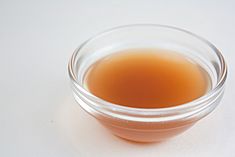Apple cider vinegar facts for kids
 |
|
| Nutritional value per 100 g (3.5 oz) | |
|---|---|
| Energy | 90 kJ (22 kcal) |
|
0.93 g
|
|
| Sugars | 0.40 g |
| Dietary fiber | 0 g |
|
0 g
|
|
|
Protein
|
0 g
|
| Vitamins | Quantity
%DV†
|
| Vitamin A equiv. |
0%
0 μg |
| Thiamine (B1) |
0%
0 mg |
| Riboflavin (B2) |
0%
0 mg |
| Niacin (B3) |
0%
0 mg |
| Vitamin B6 |
0%
0 mg |
| Folate (B9) |
0%
0 μg |
| Vitamin B12 |
0%
0 μg |
| Vitamin C |
0%
0 mg |
| Vitamin E |
0%
0 mg |
| Vitamin K |
0%
0 μg |
| Minerals | Quantity
%DV†
|
| Calcium |
1%
7 mg |
| Iron |
2%
0.20 mg |
| Magnesium |
1%
5 mg |
| Phosphorus |
1%
8 mg |
| Potassium |
2%
73 mg |
| Sodium |
0%
5 mg |
| Zinc |
0%
0.04 mg |
| Other constituents | Quantity |
| Water | 93.81 g |
| †Percentages estimated using US recommendations for adults. | |
Apple cider vinegar, also called cider vinegar, is a special kind of vinegar. It's made from apple juice that has been fermented. People use it in many ways, like in salad dressings, marinades for meat, and even to help keep food fresh.
To make it, apples are crushed and their juice is squeezed out. Then, tiny living things called bacteria and yeast are added to the juice. These tiny helpers start a process called fermentation. First, they turn the sugar in the apple juice into alcohol. After that, different bacteria turn the alcohol into vinegar. This is why apple cider vinegar has a sour taste!
Some people think apple cider vinegar can help with things like losing body weight or managing blood sugar. However, there isn't strong scientific proof that it works for these health benefits.
Contents
What's in Apple Cider Vinegar?
Apple cider vinegar is mostly water, about 94%. It also has about 5% of something called acetic acid, which gives it its sour taste. There's a small amount of carbohydrates, but no fat or protein. A small serving of 100 grams (about 3.4 ounces) has only 22 calories. It doesn't have many micronutrients, which are the vitamins and minerals your body needs in small amounts.
How Apple Cider Vinegar is Made
Making apple cider vinegar is a cool process!
- First, apples are put onto a belt and crushed.
- Then, the juice is squeezed out from the crushed apples.
- This juice is stored in large tanks. Here, the first step of fermentation begins. Tiny organisms like yeast turn the natural sugars in the apple juice into alcohol.
- Next, a special type of bacteria called Acetobacter is added. These bacteria are amazing because they change the alcohol into acetic acid. This is what makes the liquid turn into vinegar!
- Sometimes, you might see a cloudy, web-like substance in apple cider vinegar. This is called the "mother." It's a mix of the helpful bacteria and yeast that are left in the vinegar before it's filtered or heated.
Important Safety Tips
While a little bit of apple cider vinegar, especially when mixed with water, is usually fine, it's good to know some safety tips.
- Dilute it: Drinking undiluted (not mixed with water) apple cider vinegar can sometimes bother your throat or even wear away the enamel on your teeth.
- Eyes and Skin: If vinegar gets into your eyes, it can cause irritation. It's also not a good idea to put it directly on your skin to treat skin problems, as it can cause burns.
- Mixing with Cleaners: If you use apple cider vinegar as a cleaning agent at home, never mix it with chlorine bleach. Mixing them can create a gas that is harmful to breathe in and can irritate your eyes, nose, and throat.
- Allergies: If you are allergic to apples, you might also have an allergic reaction to apple cider vinegar.
- Medications: If you take any prescription drugs, like insulin for diabetes or medicines that help your body get rid of extra water (called diuretics), talk to a doctor before using apple cider vinegar. It might affect how your medicines work.
- For Kids and Pregnant Women: It's usually safe to use small amounts of apple cider vinegar for food flavoring. However, it might not be safe for pregnant or breastfeeding women, or for young children to use in larger amounts.
See also
 In Spanish: Vinagre de sidra de manzana para niños
In Spanish: Vinagre de sidra de manzana para niños

